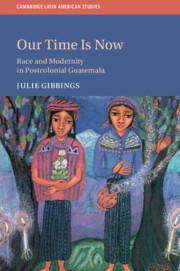Book contents
- Our Time Is Now
- Cambridge Latin American Studies
- Our Time Is Now
- Copyright page
- Dedication
- Contents
- Maps, Figures, and Tables
- Acknowledgments
- Introduction
- Part I Translating Modernities
- 1 To Live without King or Castle
- 2 Possessing Sentiments and Ideas of Progress
- 3 Indolence Is the Death of Character
- 4 El Q’eq Roams at Night
- Part II Aspirations and Anxieties of Unfulfilled Modernities
- Conclusion
- Glossary
- Index
- Cambridge Latin American Studies (continue from page ii)
3 - Indolence Is the Death of Character
The Making of Race and Labor, 1886–1898
from Part I - Translating Modernities
Published online by Cambridge University Press: 01 July 2020
- Our Time Is Now
- Cambridge Latin American Studies
- Our Time Is Now
- Copyright page
- Dedication
- Contents
- Maps, Figures, and Tables
- Acknowledgments
- Introduction
- Part I Translating Modernities
- 1 To Live without King or Castle
- 2 Possessing Sentiments and Ideas of Progress
- 3 Indolence Is the Death of Character
- 4 El Q’eq Roams at Night
- Part II Aspirations and Anxieties of Unfulfilled Modernities
- Conclusion
- Glossary
- Index
- Cambridge Latin American Studies (continue from page ii)
Summary
In 1886, a frost unleashed by the region’s most powerful mountain deity, Tzuultaq’a Xucaneb, to seek revenge for coffee production and private property set off a millennial revolt. In the wake of this moral and spiritual crisis, Q’eqchi’s searched for new intermediaries and forged cross-racial alliances. In the wake of the frost, some rural Q’eqchi’s expressed another time, deeply inflected by the belief that mountain spirits were themselves historical agents. Others opened a national debate over the place of “slavery” in a modernizing nation in alliance with ladino indigenistas. Despite the temporary abolition of coerced labor, however, a political and economic crisis in 1897 drove the return to coerced labor and set the stage for a new plantation economy.
- Type
- Chapter
- Information
- Our Time is NowRace and Modernity in Postcolonial Guatemala, pp. 111 - 149Publisher: Cambridge University PressPrint publication year: 2020

